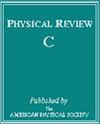从 C12 上的违反奇偶性电子散射中同时提取弱半径和弱混合角
IF 3.4
2区 物理与天体物理
Q1 Physics and Astronomy
引用次数: 0
摘要
我们研究了核结构不确定性对未来在美因茨的美因茨能量回收超导加速器(MESA)设施上测量 C12 弱电荷的影响。根据选定原子核的基态特性精确校准的大量核模型所提供的信息表明,0.3% 的正向角违反奇偶性不对称测量精度不会受到核结构效应的影响,从而可以对 C12 的弱电荷进行世界领先的测定。此外,我们还表明,在相同电子束能量下,结合对正反角度的违反奇偶性不对称的测量,可以提取核弱电荷分布的信息。我们得出的结论是,通过在后向角度对违反奇偶性的不对称性进行精度为 3% 的测量,可以实现 0.34% 的 C12 弱半径精度。本文章由计算机程序翻译,如有差异,请以英文原文为准。

Simultaneous extraction of the weak radius and the weak mixing angle from parity-violating electron scattering on C12
We study the impact of nuclear structure uncertainties on a measurement of the weak charge of at the future Mainz Energy Recovering Superconducting Accelerator (MESA) facility in Mainz. Information from a large variety of nuclear models, accurately calibrated to the ground-state properties of selected nuclei, suggest that a 0.3% precision measurement of the parity-violating asymmetry at forward angles will not be compromised by nuclear structure effects, thereby allowing a world-leading determination of the weak charge of . Furthermore, we show that a combination of measurements of the parity-violating asymmetry at forward and backward angles for the same electron-beam energy can be used to extract information on the nuclear weak charge distribution. We conclude that a 0.34% precision on the weak radius of may be achieved by performing a 3% precision measurement of the parity-violating asymmetry at backward angles.
求助全文
通过发布文献求助,成功后即可免费获取论文全文。
去求助
来源期刊

Physical Review C
物理-物理:核物理
CiteScore
5.70
自引率
35.50%
发文量
0
审稿时长
1-2 weeks
期刊介绍:
Physical Review C (PRC) is a leading journal in theoretical and experimental nuclear physics, publishing more than two-thirds of the research literature in the field.
PRC covers experimental and theoretical results in all aspects of nuclear physics, including:
Nucleon-nucleon interaction, few-body systems
Nuclear structure
Nuclear reactions
Relativistic nuclear collisions
Hadronic physics and QCD
Electroweak interaction, symmetries
Nuclear astrophysics
 求助内容:
求助内容: 应助结果提醒方式:
应助结果提醒方式:


